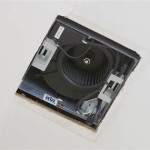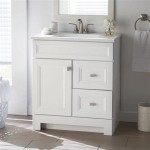Small Bathroom Vanities: Optimizing Space with 18-Inch Depth
The modern bathroom frequently presents spatial challenges. In apartments, condos, older homes, and even renovated structures, bathrooms are often among the smallest rooms. Consequently, maximizing functionality and aesthetics within limited dimensions becomes paramount. One effective solution for small bathrooms is the implementation of vanities with a depth of 18 inches. These compact units offer a reduced footprint compared to standard-sized vanities, allowing for enhanced maneuverability and a less cluttered appearance without sacrificing essential storage and sink space.
Selecting the appropriate vanity for a small bathroom involves a careful consideration of various factors, including dimensions, style, material, storage capacity, and budget. An 18-inch depth vanity presents a balance between sufficient counter space for daily necessities and minimal intrusion into the room's overall area. This article explores the benefits of using small bathroom vanities with an 18-inch depth, examining various design options, materials, and installation considerations. The aim is to provide comprehensive information for homeowners and designers seeking to optimize space and functionality in compact bathroom environments.
Understanding the Advantages of an 18-Inch Depth Vanity
The primary advantage of an 18-inch depth vanity lies in its space-saving capabilities. Standard vanities often range from 21 to 24 inches in depth, which can be overwhelming in a small bathroom. Reducing the depth by several inches creates valuable floor space, allowing for easier movement and preventing the room from feeling cramped. This is particularly crucial in bathrooms with narrow layouts or limited square footage.
Moreover, an 18-inch depth vanity can improve the overall aesthetics of a small bathroom. By minimizing the protrusion of the vanity into the room, the space appears more open and airy. This is especially important in bathrooms where natural light is limited. A smaller vanity can help to create a more visually appealing and comfortable environment.
Despite its compact size, an 18-inch depth vanity can still provide adequate storage space. Many models are designed with clever storage solutions, such as drawers, cabinets, and open shelving, to maximize functionality. These storage options can accommodate toiletries, towels, cleaning supplies, and other bathroom essentials, helping to keep the countertop clear and the room organized.
Furthermore, the availability of 18-inch depth vanities in diverse styles and materials ensures that homeowners can find a unit that complements their existing bathroom décor. Whether the preference is for a modern, minimalist design or a more traditional, ornate style, there are numerous options to choose from. This allows for customization and personalization, enabling homeowners to create a bathroom that reflects their individual tastes and preferences.
Finally, 18-inch depth vanities can be more cost-effective than larger units. The smaller size typically translates to lower material costs and reduced manufacturing expenses. This can make them an attractive option for homeowners on a budget who are looking to renovate their bathroom without breaking the bank.
Exploring Different Styles and Designs of 18-Inch Depth Vanities
The market offers a wide variety of styles and designs for 18-inch depth vanities, catering to diverse aesthetic preferences and functional requirements. These vanities can be broadly categorized based on their mounting style, door and drawer configurations, and overall design aesthetic.
Wall-Mounted Vanities: These vanities are attached directly to the wall, creating a floating effect that enhances the sense of space in a small bathroom. Wall-mounted vanities are particularly suitable for minimalist and contemporary designs. They allow for easy cleaning underneath the unit and can be installed at a height that is comfortable for the user. The storage space in wall-mounted vanities is typically limited to drawers and cabinets, but the open space beneath can be utilized for storing baskets or other decorative items.
Freestanding Vanities: Freestanding vanities are the most common type and rest directly on the floor. They offer a wider range of storage options, including drawers, cabinets, and open shelving. Freestanding vanities are available in various styles, from traditional to modern, and can be easily integrated into existing bathroom layouts. They provide a stable and sturdy base for the sink and countertop.
Corner Vanities: Corner vanities are designed to fit snugly into the corner of a bathroom, maximizing space utilization in awkward or tight areas. They are particularly useful in bathrooms with unconventional layouts or limited wall space. Corner vanities typically feature a triangular or curved design and offer a combination of drawers and cabinets for storage.
In terms of design aesthetics, 18-inch depth vanities are available in a variety of styles, including:
Modern Vanities: These vanities feature clean lines, minimalist designs, and contemporary materials such as glass, metal, and engineered wood. They often incorporate features such as integrated sinks, handleless drawers, and LED lighting.
Traditional Vanities: Traditional vanities are characterized by ornate details, classic lines, and rich wood finishes. They often feature raised panel doors, decorative hardware, and marble or granite countertops.
Rustic Vanities: Rustic vanities evoke a sense of warmth and natural beauty, featuring distressed wood finishes, exposed hardware, and farmhouse-inspired details. They are often made from reclaimed wood or other sustainable materials.
Transitional Vanities: Transitional vanities blend elements of both modern and traditional styles, creating a balanced and versatile aesthetic. They typically feature clean lines with subtle details and can be easily integrated into a variety of bathroom decors.
Selecting the Right Materials for Durability and Aesthetics
The choice of materials for an 18-inch depth vanity is crucial for both its durability and aesthetic appeal. Different materials offer varying levels of resistance to moisture, wear and tear, and chemical exposure, as well as contributing to the overall look and feel of the bathroom.
Wood: Solid wood is a classic material for bathroom vanities, offering natural beauty and durability. However, solid wood is susceptible to moisture damage and requires regular maintenance to prevent warping, cracking, and mildew growth. Hardwoods such as oak, maple, and cherry are more resistant to moisture than softwoods such as pine.
Engineered Wood: Engineered wood, such as plywood and MDF (Medium-Density Fiberboard), is a more affordable and moisture-resistant alternative to solid wood. Engineered wood is made from wood fibers that are bonded together with resins, creating a stable and durable material. It is less prone to warping and cracking than solid wood and can be easily painted or veneered to achieve a variety of finishes.
Laminate: Laminate is a synthetic material that is applied to a substrate such as MDF or particleboard. Laminate is highly resistant to moisture, scratches, and stains, making it a practical choice for bathroom vanities. It is available in a wide range of colors, patterns, and textures, allowing for versatile design options.
Metal: Metal vanities are often used in modern and contemporary bathrooms, offering a sleek and industrial aesthetic. Stainless steel and aluminum are popular choices for their durability and resistance to rust and corrosion. Metal vanities are typically easy to clean and maintain.
Stone: Stone countertops, such as marble, granite, and quartz, add a touch of luxury and elegance to bathroom vanities. Natural stone is durable and heat-resistant, but it can be porous and require sealing to prevent staining. Quartz is a manufactured stone that is non-porous and highly resistant to stains and scratches.
Glass: Glass countertops and sinks can create a modern and sophisticated look in a bathroom. Glass is non-porous and easy to clean, but it can be fragile and require careful handling. Tempered glass is more resistant to breakage than standard glass.
When selecting materials for an 18-inch depth vanity, it is important to consider the overall style of the bathroom, the level of maintenance required, and the budget. Choosing durable and moisture-resistant materials will ensure that the vanity lasts for many years and retains its aesthetic appeal.
Furthermore, the hardware used on the vanity, such as knobs, pulls, and hinges, should also be chosen with care. High-quality hardware will not only enhance the appearance of the vanity but also ensure smooth and reliable operation.
The sink is another important consideration when selecting a vanity. Undermount sinks, which are installed beneath the countertop, create a seamless and easy-to-clean surface. Vessel sinks, which sit on top of the countertop, add a touch of drama and visual interest. Integrated sinks, which are molded directly into the countertop, offer a sleek and modern look.
In conclusion, selecting an 18-inch depth vanity requires a thoughtful assessment of space constraints, design preferences, and functional needs. By carefully considering the various styles, materials, and storage options available, homeowners can create a bathroom that is both stylish and practical, maximizing the potential of even the smallest spaces.

Narrow Depth Bathroom Vanities Signature Hardware

Small Bathroom Vanities Thebath

18 In Bathroom Vanities At Com

Narrow Depth Bathroom Vanities Signature Hardware

The Best 20 Small Bathroom Vanities Of 2024

The Best 20 Small Bathroom Vanities Of 2024

6 Space Saving Vanities For Small Bathrooms Unique

18 In Bathroom Vanities At Com

Diy Bathroom Vanity For 65 Angela Marie Made

6 Space Saving Vanities For Small Bathrooms Unique
Related Posts







